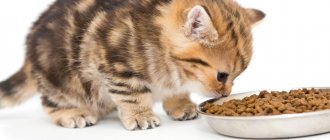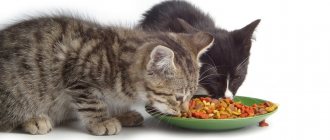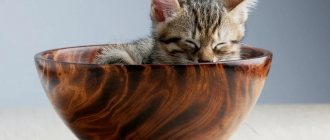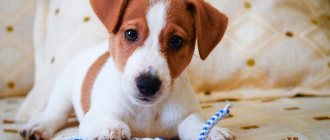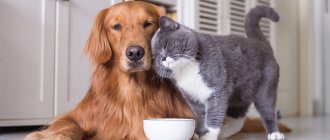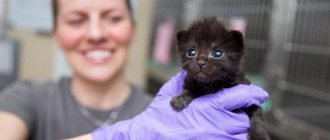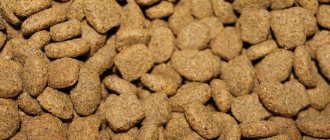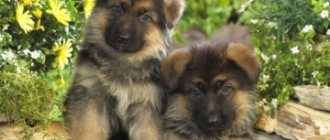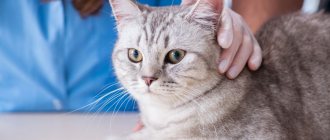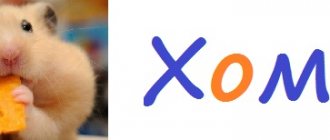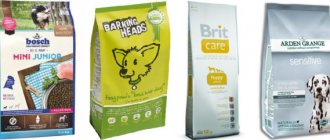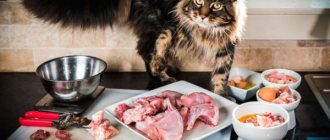Cat breeders try to feed their pets correctly. Proper nutrition will be the key to the health and beauty of the animal. Feeding only dry cat food will be an ideal option for those who want to raise their pet on high-quality, relatively inexpensive food, without having problems with quickly perishable foods, as well as preparing natural food.
Feeding principles
Good dry food contains all the necessary components to maintain health and replenish your pet's energy reserves. Owners who have chosen this type of feeding must follow several basic rules:
- do not mix “drying”, pates or homemade dishes in one bowl;
- provide the cat with sufficient drinking regime, since the pet must consume at least 20 ml of water for every kilogram of weight;
- do not change the type of feeding and brand of food unless necessary;
- Follow the daily intake of granules indicated on the packaging.
Everyone loves to eat.
A cat should eat according to a schedule, the number of meals per day depends on the age of the pet: kittens aged 3-4 months eat four times, 5-6 - three times a day. After six months, babies should gradually be transferred to an adult, two-times-a-day regimen.
It is optimal because the cat is an obligate (obligate) predator. Her digestive system is designed to digest animal protein. The process takes 10-12 hours. The digestion time of high-quality dry food is as close to natural as possible, so the specified interval between meals must be observed. Pregnant and lactating females should be fed three times a day.
Provided that these rules are followed, “drying” has many advantages. The main ones:
- convenience and ease of use;
- the ability to control caloric intake;
- enrichment with vitamins and microelements;
- long shelf life;
- taste attractive to pets;
- stable functioning of the digestive tract.
The disadvantages of “crackers” are their low water content and the presence of a huge number of poor quality products on the market.
Psychological comfort
If an adult cat eats little or a lot and you are already tired of changing food, it may be worth thinking about the environment in which the pet eats. We have already said that one of the main problems may be a nervous environment when eating in the “cat canteen”.
How do you understand that there are problems and what can be done about it?
| The main thing that any pet should feel around its bowl is safety. If something frightens a cat, it will either try to eat in a hurry (which is not very healthy), or will begin to refuse food altogether. |
Here are signs that something is bothering your cat:
- wary, fearful behavior, the animal flinches at every rustle;
- constant attempts to look around;
- ears erect or “in airplane position” (set apart horizontally);
- the cat is hunched over or curled up into a ball.
So what makes a cat nervous? Perhaps it's other family members. Let's say the bowl is in the hallway and passing family members disturb the dining pet. Or an overly playful or loving preschool child terrorizes a pet without realizing it.
Then try moving the bowl under the table or to another hard-to-reach place. Sometimes the problem can be solved by turning the eating area so that the cat sits with its back to a wall or other safe area for it. Some “vertical” cats who like to climb and jump are happy to have their food bowl moved onto a nightstand or low shelf.
Which one is better?
All dry food is divided into four classes:
- economy;
- premium;
- super premium;
- holistic.
This gradation is not officially approved; it is often used by manufacturers to raise the prestige of their products. When choosing “drying”, experienced owners pay attention primarily to the composition of the feed, and not its class.
Kitty cat
Economy
The first group includes products sold in supermarkets:
- Whiskeys;
- Kitekat;
- Friskies;
- Darling;
- Felix;
- Cat Chow;
- Sheba;
- Perfect Fit;
- ProTail;
- Our brand and others like it.
They attract owners with low prices, bright packaging and active television advertising. However, such food is useless for animals, and if consumed continuously for a long time, it is extremely harmful.
Having carefully read the composition of an economy class product, you can find out that meat and offal in their composition account for only about 15%. Moreover, this category includes all waste from the meat industry (horns, hooves, beaks, intestines with their contents, blood, etc.). The bulk of cheap feed comes from cereals, vegetable fats, and processed vegetable products. These components will not add health to your pet. The main harm is caused by various chemical dyes, preservatives, and flavoring additives. The latter explain the high degree of habituation to low-quality food of usually selective cats.
This composition “hits” the internal organs of a small predator. Irreversible consequences occur in the liver, kidneys, spleen, pancreas, and stomach. There are quite a lot of owners who claim that their pet has been eating cheap food for many years and everything is fine with it. Veterinarians say this is a temporary effect. The consequences of constant consumption of such feed are inevitable. They don't always come right away. In animals with strong immunity, they may be delayed, but improper nutrition will definitely affect the life expectancy of your furry pet.
Royal Canin
Premium
These foods differ from the economy version in a better composition, but this is also not an ideal option for adequate nutrition for a cat.
This group includes products from such brands as:
- Royal Canin;
- Hills;
- Pro Plan;
- Organix, Happy Cat;
- Schesir;
- Night Hunter;
- Nero Gold and others.
In addition to offal, they contain meat, but not much of it. Premium food also contains a lot of grains, but also contains vegetables, eggs, and vitamins (the packaging indicates which ones and in what quantities). The content of harmful synthetic additives and soy is minimal. The downside is the lack of information about what specific preservatives were used in production.
It is worth noting that the composition of premium food varies greatly (even in the lines of the same manufacturer). This allows you to choose a completely acceptable product at an affordable price.
Landor
Super premium
This category includes high quality products. Breeders consider super-premium feed to be optimal in terms of price-quality ratio.
The most famous brands in this group:
- 1st Choice;
- Bozita;
- Landor;
- Savarra;
- Brit Care;
- Leonardo;
- Vet Life.
They contain the bulk of the composition of natural meat, vegetables, seeds, oils, and herbs. There are few cereals, the manufacturer chose the most suitable for cats (barley, rice, oats). Natural substances are used as preservatives, without “chemicals”. The feed components are varied.
Akana
Holistic
Products of the highest quality are produced under the following brands:
- Acana;
- Grandorf;
- Orijen;
- Wildcat;
- Applaws;
- Farmina N&D;
- Go Natural;
- Nutram.
The share of natural, dehydrated meat in holistic foods reaches 80%. Also in the composition of different types of food there are: fish, vegetables, oils, fruits, fats, berries, vitamin supplements. There are practically no grains, some have a little rice. Products for such feed are grown in environmentally friendly areas.
Some companies (such as Champion PetFoods) produce products according to the WholePrey principle. The uniqueness of the development lies in the fact that the food is as close as possible to that obtained by a predator in its natural environment. To do this, not only muscle fibers of meat are added to the feed, but also cartilage, entrails, etc.
Holistic formulas are by far the best option for constant feeding of cats, but they are quite expensive.
Medicinal foods should be included in a separate group. They are intended for individuals with various chronic diseases. They can only be given to cats as prescribed by a veterinarian!
About classes
All dry food is divided into the following classes:
- economy - the most harmful for regular consumption. They do not contain meat.
It is replaced by bone meal and soy. The food contains flavor enhancers, dyes and flavors that make it attractive to pets; Vaska Kitekat Whiskas
For a long and healthy life for your cat breed, these foods are not recommended by veterinarians. After prolonged use, pets develop diseases of the gastrointestinal tract and urinary system.
- premium _
The advantage of the food composition is the content of meat (most often chicken), egg whites, high-quality by-products, fiber, a carefully selected vitamin complex and the presence of essential amino and fatty acids. The downside is the presence of grains (wheat, oats, corn), which can trigger the development of allergies, as well as soy protein, which is harmful to joints; Gina Doctor Alders Happy cat
These foods can be given to cats for quite a long time without any visible damage to their health. A wide range of “drying” products of this class allows you to choose food for your pet, consistent with his personal preferences and health status.
- super premium .
The undoubted advantage of the food is the complete absence of soy protein, gluten, dyes, flavors, flavor enhancers and preservatives. The composition includes high-quality meat, vegetable fiber, a small amount of offal (up to 2%), as well as a little brown or white rice; Bozita Pro Plan Royal Canin
In the absence of flavorings, cats may be reluctant to eat food at first, but over time, even the most fastidious of them get used to it, appreciating the surge of strength and energy.
- Holistic is the top of the food pyramid among all dry foods.
They are produced from environmentally friendly products using carefully developed technology; go! Innova almo nature
These foods are ideal for regular use. The downside is the high price and inconvenient packaging (no zipper).
Table 1. Digestibility and content of harmful substances.
| Class | Digestibility, % | By-products and preservatives | Flavor enhancers |
| Economy | 35-45 | Yes | Yes |
| Premium | 55-65 | Sometimes | No |
| Superpremium | 70-80 | No | No |
| Holistic | 85-90 | No | No |
When purchasing dry food, it is recommended to also pay attention to the manufacturer. Preference should be given to products manufactured in Denmark, Great Britain, Canada, USA, Germany.
Nutritional standards by weight, table
Overfeeding and not enough food are equally harmful to cats. Feed dosages are indicated on the packaging; they differ from manufacturer to manufacturer. If the owner combines “drying” with wet food, you need to ensure that spiders account for no more than 25% of the total diet. They are quickly digested, cats love them and eat much more than they need. This can quickly lead to obesity and related problems.
We present the average normative data in the table:
| cat weight (kg) | daily norm when feeding only dry food (g) | daily intake for mixed nutrition (g) |
| until 3 | 25 | 15 + 1 spider |
| from 3 to 4 | 40 | 25-30 + 1.5 pouches |
| from 4 to 5 | 60 | 25–45 + 1.5 pouches |
| more than 5 | 12 g per kg of weight | 35–60 + 2 spiders |
These standards are average. Various factors influence the amount of feed consumed. The main ones:
- age of the cat;
- pet's activity level;
- breed;
- health status;
- gender
Most manufacturers produce lines of food for different individuals (for example, for active or couch potatoes, for kittens, adults or elderly, for sterilized individuals, and others). Even for hairless breeds there are specialized foods. So if you have a Sphynx, Elf, Bambino, Dwelf, Minskin or Ukrainian Levkoy, there will be no problems. In addition to following the instructions on the package, it is advisable to consult with a veterinarian, who will give the necessary recommendations on the rate of food consumption and the type of feeding of a particular individual.
The class of food has a great influence on the amount of food required. The higher it is, the fewer granules are required to saturate the cat. Accordingly, the consumption of economy class feed with low nutritional value will be much higher than that of super-premium or holistic products.
Dry food for kittens
How to translate correctly, at what age is it better
You can replace your cat's natural diet with dry food at any age. Moreover, doing this is much easier than the other way around (transferring your pet from “drying” to homemade food).
A complete change of feed with the right approach takes from 7 to 14 days.
Small kittens get used to innovations much faster, but they should be offered hard granules no earlier than three months, after the formation of baby teeth is complete. And especially not for kittens aged one month, they have a special diet.
From the fourth week, babies can be supplemented with special holistic products (such as Orijen, Felidae) in combination with cat milk substitutes. This diet stabilizes the intestinal microflora.
Kittens older than three months can be gradually introduced to the new food. To make the process painless, it is better to give him his usual food in the morning and the chosen “drying” in the evening. Be sure to leave a bowl of clean water. After a few days, most kittens begin to prefer dry food.
When it is necessary to change the diet of an adult cat, you need to act more carefully. Cats are conservative and have difficulty accepting anything new. First, you should make sure that the pet is completely healthy and has no problems with stool or urination.
If the digestive and excretory systems of the pet are functioning normally, you can begin to introduce “drying”. First, you need to introduce several soaked granules into your usual food, each time increasing the percentage of the new food in relation to the previous one. It is necessary to soak the granules until they completely switch to a dry product in order to facilitate the digestion of components that differ in structure.
Some owners practice the method of fasting until the cat begins to eat new food. This method can only be used if the pet is young and completely healthy. In addition, prolonged absence of food negatively affects the cat's condition. Hunger for more than two days can provoke irreversible changes in the liver of a pet. It is better to carry out the replacement without stress for the pet’s body. A hunger strike is justified only when switching from economy-class products to higher quality ones.
Dangerous! “Drying” should not be administered to sick, older individuals, pregnant or lactating females, or cats with kidney or genitourinary diseases.
During the food change and a couple of weeks after the complete transfer, the cat must be closely monitored. If he develops a rash, itching, or digestive disorders, he should return to his previous diet and try a different brand of food after about a month. Some cats naturally drink very little water. Feeding dry granules is contraindicated for such individuals.
Refused to eat
What to do if you stop eating
If your pet suddenly refuses to eat its usual food, you must first find out the reason for this behavior. First of all, you need to check whether the product has deteriorated.
This may occur due to violation of storage rules or expiration date. In this case, you should immediately throw away the food and buy a new bag.
Perhaps the granules stopped attracting the cat because they lay in the bowl for too long and “fizzled out.” Cats have few taste buds on their tongues; the main thing for them is the smell; if some of it is lost, the fuzzy fussy cat will lose interest in the dish. To correct the situation, just add a little fresh food and your appetite will be restored.
Another reason for refusing to eat may be the pet receiving excess treats or snacks during the day. Seals sometimes become capricious when fed a mixed type of feeding, thus begging for pouches or pates. To return to the established diet, you should temporarily exclude all “goodies” and offer only “drying” (twice a day) and water.
Cats eat less after suffering stress (for example, moving), in extreme heat. Females lose their appetite during estrus, males - during the period of sexual heat. These disorders go away on their own over time. To prevent eating disorders, your pet needs to be calmed, cuddled, and given access to fresh water. It is advisable to castrate individuals not participating in breeding. This will help avoid many pet health problems and most behavioral disorders. You also need to keep your cat's dishes clean; squeamish cats won't eat from a dirty bowl.
The situations listed above are not a cause for concern. But, a decrease (or loss) of interest in food is accompanied by most serious diseases of domestic animals. You need to be especially careful when food refusal is accompanied by:
- increased temperature;
- vomiting;
- lethargy;
- desire to hide;
- diarrhea;
- discharge from the nose or eyes;
- constipation;
- skin rashes;
- deterioration in wool quality.
If your cat exhibits at least one of the listed symptoms, you need to visit a veterinary clinic as soon as possible. In most cases, the success of treatment depends on how quickly it is started.
These are not crackers, this is a complete food
Why dry food is so good: 7 pros
If dry food were such an unambiguous evil, as ardent supporters of the natural type of feeding believe, it would not be so popular. Thousands of cats live full lives on industrial diets. Let's look at the advantages of this type of feeding.
Balance of proteins, fats, carbohydrates, vitamins and minerals
If you feed your cat table scraps or even meat porridge specially prepared for it, you hardly know how many calories your pet receives per day. And if you feed with food, then everything is like in a pharmacy. This is especially important when it comes to preventing obesity in neutered animals.
Even in inexpensive feeds, manufacturers maintain the percentage of proteins, fats and carbohydrates. Cat food should contain 30-40% protein and 10-25% fat. These rates may vary for different age groups and health conditions.
Vitamins and individual amino acids (taurine) are added to the feed to compensate for their loss in products after heat treatment. The composition also indicates the exact amount of fat-soluble vitamins A, D, E.
The feed contains the correct ratio of calcium to phosphorus, as well as their total amount. Therefore, industrial diets help to avoid rickets in kittens (with natural feeding there is a risk of developing nutritional osteodystrophy).
Feed is a complete product. There is no need to buy or give vitamins or mineral supplements. The pet will receive all the necessary substances with food.
Secondary hyperparathyroidism is common in kittens that eat only meat
Treatment and prevention
These foods are very convenient if your cat has special needs or a chronic illness. Leading manufacturers have therapeutic diets for any situation: for diabetic cats, for cats with kidney failure, with chronic constipation, and so on. It’s really not easy to create a therapeutic diet at home, and getting a cat to eat it later is even more difficult. Veterinary dietetics is a very young science: doctors prefer ready-made solutions in the form of industrial feed. At home, you cannot break down protein into molecules or add individual amino acids to food - but this is possible in production.
Foods for removing fur are convenient for furry animals: otherwise, you need to regularly give your cat malt-mast. Foods for older animals contain a lot of fiber to promote regular bowel movements. Chondroprotectors (glucosamine and chondroitin) are added to food for cats with joint diseases. In other words, for every problem there is a solution.
Fractional meals
The cat should eat often, but little by little. It was as if she caught a mouse, ate it whole, and went after the next one. But when owners work, they can only feed the pet 2-3 times a day.
Homemade or canned food may turn sour or stale in the bowl if the cat does not eat it all at once. Nothing will happen to dry food, and you can pour the daily portion at once so that the cat comes up to eat a little throughout the day. Some owners even leave the cat in the apartment for a day, giving it more food or using an automatic feeder.
Convenient, fast, easy
It’s definitely easier to pour food into a bowl than to buy meat for your cat, cook porridge, cut it, mix it, and add vitamins. If your pet eats dry food, you can even entrust feeding it to children who are delighted with such a responsibility. You can ask friends or relatives to feed your cat while you are on vacation.
Eating at home is more difficult. Cooking every day takes a lot of time, and if you make and package it for future use, you need to defrost and reheat.
Stability
If the food suits the cat, digestion will be stable. Only with an industrial type of food, the owner knows exactly how often his cat goes to the toilet. Therefore, if there are disturbances in the functioning of the intestines, he will not sin on food, but will immediately contact a veterinary clinic to find out the cause.
Cats like dry food
Although plain brown crackers don't seem attractive to us, cats enjoy eating dry food. Entire scientific laboratories are working to make food appetizing to cats.
This cat is clearly happy with her lunch
Cats have fewer taste buds than dogs or humans. Their tongue is covered with a stratum corneum; they have difficulty distinguishing the taste of food. Cats rely on smell.
A cat can eat the same food for years without getting tired of it. But in the case of homemade food, the pet can be picky - he will eat something, but absolutely not something. If your cat eats only meat, leaving cereals and vegetables in the bowl, it will not be easy to balance its diet.
With selective eating, especially in kittens, feeding dry food will be healthier than natural food.
Budget savings
Cats are relatively small animals, weighing 2.5-7 kg. Therefore, you can afford to buy them really expensive food.
Personal experience: a cat weighing 3.5 kg eats Now Natural Holistic food costing about 700 rubles. for 1 kg. The feeding rate is 50 grams per day, that is, about 1.5 kg per month. A little more than 1000 rub. per month. This is cheaper than feeding your cat even the cheapest canned food. But there are many decent feeds much cheaper (500-600 rubles/kg).
Misconceptions
There are many myths about dry food among ordinary people. Most of them are not true. Let's take a closer look at the most popular judgments:
- There is an opinion that cats develop urolithiasis from drying out. In fact, pathology occurs against the background of excess carbohydrates in the diet and insufficient fluid intake. This is associated with the consumption of food only if the pet drinks little water.
- Some believe that commercial diets for cats have the same nutritional value as crackers for humans. In fact, the technology for their manufacture is completely different. Natural products needed by predators are crushed, dehydrated, and mixed. After this, the food is enriched with vitamins and minerals.
- “Drying” contains ash, which, according to some owners, causes urinary tract diseases. Research suggests that this element does not affect urination in any way. The problem can be caused by grain components of cheap feeds, which increase the alkaline reaction of urine.
- Unfortunately, nutritional granules do not help clean teeth because they do not contain abrasives.
- The statement that high-protein diets are harmful for cats is based on the inability to distinguish between plant and animal proteins. An excess of the former really has a bad effect on the health of small predators. While animal proteins are most consistent with the nutrition of cats in their natural environment, and therefore are necessary for them.
When choosing food, it is worth considering that manufacturers of economy class products actively advertise their products on television. Companies that produce premium food often participate in cat exhibitions and place branded booklets in veterinary clinics. While high-quality super-premium and holistic products are practically not promoted to the market. It is important to remember that advertising is not a recommendation for use. Before purchasing food, you should carefully read its composition.
About the composition
Proper dry food includes:
- quality meat;
- protein - most often egg or soy;
- cellulose;
- vitamins, amino acids (for example, taurine or tryptophan), minerals.
The presence of flavors and dyes is not welcome. This also applies to preservatives and low-quality by-products (bone meal, leather, etc.).
The right composition - a healthy cat
When buying food, it is quite difficult to navigate among the huge assortment. Therefore, it is more convenient to make a choice after becoming familiar with the classes of dry food.
Is it worth it at all?
The debate about what to feed a cat, dry food or natural food, has been going on for decades. When choosing the option that suits you, you need to consider:
- cat's food preferences;
- pet's health status;
- breeds;
- the degree of employment of the owners.
Advice! If your cat categorically refuses to eat crackers, but loves home-cooked food, you should meet her halfway.
There are few such individuals. Most cats, for example breeds such as the Pixie-Bob or the Japanese Bobtail, are happy to switch to drying. This feeding option is primarily convenient for owners who are busy at work. The finished product does not require time to prepare and does not spoil for a long time.
“Drying” is ideal for novice owners, since it does not require skills in preparing a complete cat diet. It contains all the vitamins and microelements the pet needs (with the exception of economy class food). The cat is not picky about eating vegetables, fruits, and herbs.
Eating “crackers” cats lose interest in natural food. They most likely will not pick up pieces on the street or eat mice or birds. This will significantly reduce the likelihood of poisoning.
Choosing good food
How not to make a mistake? There are several rules:
- Don't settle for a universal option. At a minimum, you need to take into account the needs of cats. A sterilized cat has different needs from a small kitten. The needs of elderly indoor cats are different from those of highly active outdoor cats.
- Read the ingredients. Not only analytical, but also a detailed breakdown of products. It is in your best interest to find cat food that tells you how much and what your pet eats.
- Read reviews from owners. Unfortunately, they are often biased, as are the recommendations of private veterinarians. But after spending quite a bit of time, you can form your own opinion.
- Give it a try. If the cat eats without problems, there are no changes in behavior, allergies, or intestinal disorders, the food is suitable. You can look at the reaction. A violent manifestation of emotions, “hungry eyes”, obvious signs of addiction are already a bad “bell”.
It is important to know what kind of cat food is actually produced and what is their difference:
- economy The class includes the cheapest options. Feeding is obviously fraught with problems for the cat. There’s definitely no meat here, but there’s more than enough surrogates. The composition is often only analytical. It is impossible to say exactly why it is harmful, only in general;
- premium There are artificial additives in this food, but the content is an order of magnitude better than in the previous version. If you wish, you can find quite decent options for feeding cats. True, the quality of raw materials is not always impressive;
- super premium. Certified food, with good content, which does not contain flavorings and dyes. Often expensive, but high quality. The class is heterogeneous;
- holistic. It would be wrong to separate this food into a separate class, but this is required by the “best of the best” positioning. This dry cat food, unlike super premium food, is prepared from foods that humans eat.
Is drying only allowed?
High-quality dry food is developed in such a way that it is a source of all the substances a cat needs. Therefore, it is even good to feed your pet exclusively with this product, provided that the food is of high quality.
Warning! You should not give only “drying” to cats that drink little water. This can lead to diseases of the urinary system!
To ensure that the product you are purchasing is complete, you need to carefully examine the packaging. Such feeds are marked “complete feed”. If it exists, adding anything to the cat’s food is even harmful. The introduction of other types of food can upset the balance of components in the pet’s body, provoke disturbances in the functioning of the gastrointestinal tract, and exacerbation of chronic pathologies.
Dog food
Appropriate place
Finally, we note that it is completely unacceptable to place a bowl of food near the tray or in the bathroom. Some owners do this with what they think are the best intentions: after all, scattered food is much easier to remove from the tiles. We can only answer one thing: if perfect order in the house is so important to you, be prepared to clean up after your pet.
Feeding a cat next to the litter box is guaranteed to “break” its feeding behavior: these animals do not naturally make a toilet in the place where they eat.
___________
© All rights reserved. Partial or complete use of materials is permitted only if there is a link and/or a direct hyperlink open to search engines to the direct address of the material on the website Holistic-shop.ru.
Is it possible for dogs
Dog food is absolutely not suitable for cats. The physiology of these animals varies greatly; nutrition is selected in accordance with the needs of each species.
Dog food contains an insufficient amount of proteins and fatty acids for cats, the amino acid taurine (the dog’s body synthesizes it independently), and eggs. But there are grains that are harmful to cats.
Proper feeding of a dog is significantly different from feeding a cat!
The consequences of eating dog food in cats are:
- joint diseases;
- urolithiasis disease;
- blurred vision;
- cystitis;
- digestive disorders.
If animals of different species live in the same house, cat feeders should be placed on elevated areas where “neighbors” cannot reach. Cats will have to be monitored to ensure they do not eat from dog bowls.
Is it possible different
You cannot mix food from different manufacturers. They may have a different balance of nutritional components, which can cause digestive disorders. It is permissible to combine products of different brands only when transferring a cat from one type of “drying” to another.
Wet food and dry food from the same manufacturer are quite compatible. Veterinarians advise this way to diversify the diet of cats with poor appetite, when the pet is in a weakened condition (after illness, surgery, etc.), or with dental problems. You can combine feed in several ways:
• give wet pieces in the morning, after 4 hours put a bowl with granules, at night - only water and special grass; • one day - wet food 4 times, the next - dry food 2 times. This option is especially good for cats with dental problems. If the cat cannot chew hard granules, they can be soaked in water to a pasty consistency and fed through a syringe without a needle in small portions every 3 hours.
Dangerous! Mixing dry and wet food in one meal is prohibited!
It is not recommended to feed a cat only spiders, since they are digested very quickly, the pet experiences hunger and begins to overeat. In addition, wet, soft pieces get stuck between the teeth, rot, and provoke inflammatory processes in the oral cavity.
You can’t combine “drying” with natural products either. The processes of digestion of these two types of food are very different: both in the time of absorption and in the composition of the necessary enzymes. With constant feeding in this way, a cat may develop gastrointestinal diseases, but sometimes it is permissible to treat a pet “on drying” to beef or turkey. Some breeders develop proprietary mixed diets. It is better not for a person without sufficient experience and knowledge to conduct such experiments on cats.
Convenient food bowl
Next, you need to make sure that the bowl is comfortable for your pet. A classic mistake is to feed your cat from a “human” plate or salad bowl. You also need to be careful with bowls that are too deep and narrow: your pet’s muzzle will, of course, fit in there, but its whiskers will touch the edges. Some cats are so unnerved by this that they completely refuse to eat.
| If there are several pets living in the house, then each should have their own bowls of food and water. Surprisingly, eating problems are more common in households with two or more cats than in households with a cat and a dog. However, we will devote a separate article to the topic of “multi-cat” houses. |
The need for vitamins
Any vitamin and mineral complexes can be given to cats only as prescribed by a doctor. An excess of active substances is no less harmful than their lack.
When feeding your pet a complete diet, supplements are usually not required as it contains everything needed. Owners do not even have to separately provide a special paste for removing lint; it is present in types of food for long-haired breeds (the packaging should be marked “hairball”).
Strictly prohibited, this is for the people
Can I eat from my own table?
Food from the human table is absolutely not suitable for a cat, regardless of the type of feeding chosen. Not only is it not beneficial, but it can also be poisonous to your pet.
Particularly dangerous for predators:
- fried, fatty foods;
- chocolate;
- spices;
- pickles;
- cakes and pastries with butter cream;
- marinades;
- sauces;
- mushrooms;
- nuts.
Dangerous! Even a small amount of such food can provoke irreversible changes in the cat’s liver, kidneys, pancreas, and gastrointestinal tract. Combining junk food with dry food will create even more stress on your pet's digestive tract.
What not to do
Inexperienced owners of furry predators, even when purchasing the highest quality “drying” for their pets, make serious mistakes that negatively affect the cat’s health.
When feeding a cat with dry food, the following is prohibited:
- replace water with milk. The body of an adult animal does not digest lactose;
- overfeed;
- add “crackers” to natural food (or pouches to granules) to improve appetite;
- offer expired products;
- strive to diversify your diet. Cats are conservative animals. They do not need a variety of dishes, and constant changes cause them digestive disorders;
- give kitten food to adults and vice versa.
You can't suddenly change your diet. Even one-time, deciding to please your pet with an expensive product after receiving a bonus. All changes should occur smoothly, gradually, as comfortably as possible for the cat.
You must follow a diet
What are the consequences of violations?
Proper nutrition is the basis for the health and longevity of a domestic cat. Eating disorders can cause serious illnesses.
Among them:
- diabetes;
- allergy;
- gastritis;
- pathologies of the liver, kidneys, pancreas;
- cardiovascular diseases;
- stomach ulcer;
- urolithiasis disease;
- tartar, caries.
With an incorrect diet or constant consumption of economy class food, cats develop vitamin deficiency. Lack of vitamins is especially dangerous:
- E (tocopherol) – leads to deterioration of hair, pathological changes in muscles, infertility;
- C – weakens the immune system, provokes dental problems;
- D – leads to developmental delay, musculoskeletal disorders, rickets;
- A – is fraught with deterioration of vision, disturbances in the functioning of the reproductive and respiratory systems;
- B – causes weakness, alopecia, loss of functionality of the musculoskeletal system.
Most diseases in cats are accompanied by a deterioration in appetite, so there is no need to immediately change food. First, you should consult a veterinarian and begin treatment in a timely manner.
Expert advice
It is important not only what to feed the cat, but also how to do it. Breeders do not recommend free access to food. Dry food is suitable for this. It doesn’t spoil, you can pour a large bowl and go to work without worrying that the cat is hungry. However, cats have a poorly developed satiety system. Most pets immediately destroy their daily supply. The stomach stretches, the cat begins to overeat, which leads to obesity.
Warning! The daily nutritional intake must be calculated taking into account the treats provided.
It is better to use a system of limiting the amount of feed and feeding regimen. With this approach, the cat receives an amount of food that it eats immediately, strictly at a certain time. Even if she didn’t finish the portion, the leftovers should be removed and given at the next feeding. The digestive system will “get used” to the schedule and work better. To achieve the desired result, electronic or automatic feeders are suitable. They can be set to a specific time and number of pellets.
The main task of the owner is to provide the cat with enough water. If your pet doesn’t drink much, it’s good to experiment with the size of the containers, placing them in different rooms. Breeders note that most indoor predators prefer wide containers, when using which the whiskers do not touch the edges of the dishes and do not get wet. Some individuals prefer to drink from special fountains or from a tap. But you should not allow your pet to get water from the toilet. This habit is fraught with infection by pathogenic microorganisms or poisoning from detergent residues.
Ragdoll cat breed, description of colors and photos, as well as their character, standards and sizes
Cats need grass to maintain their intestinal microflora. Sprouted greens or their seeds can be purchased at a pet store.
When feeding your pet dry food, you need to carefully monitor the frequency of his urination. When the litter in the tray remains dry throughout the day, the cat should be immediately given water from a syringe and consult a doctor.
The importance of water
When feeding pelleted diets, it is important to give your pet enough water. Lack of fluid leads to diseases of the genitourinary system.
If a cat refuses to drink water, dry food is contraindicated. You should consult your doctor for advice and choosing the right nutrition system.
Some pets do not want to drink water from a bowl and require tap water or drink from a can. You should not prohibit your animal from using such methods of obtaining liquid. The only contraindication is water from the bathroom, where you can pick up germs and be poisoned by detergents.
For restless pets, it is recommended to purchase a drinking fountain. Animals like running water, some like to play with the stream of liquid. In any case, the desire for clean drinking water should be encouraged, especially in animals that eat dry food.
1111
